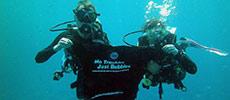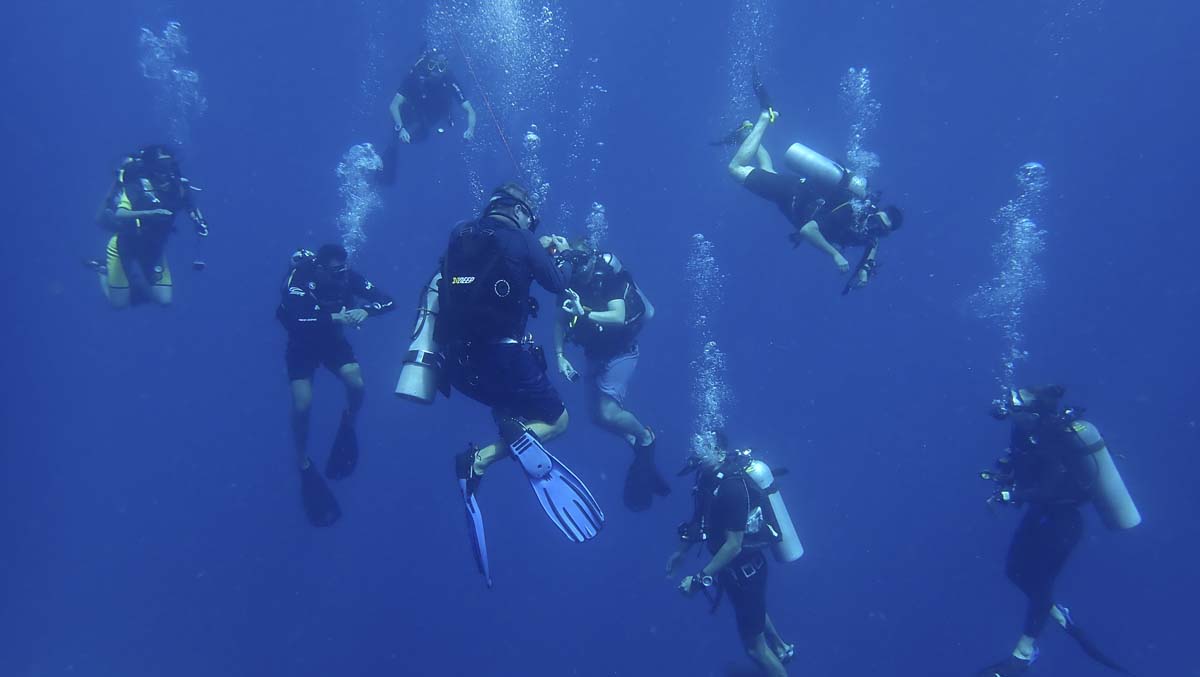 Safetey stop - credit Jon Parr
Safetey stop - credit Jon Parr
Scuba diving is a perfectly-safe activity if certain procedures are followed. Diving ‘incidents’ such as The Bends are extremely rare, and are sometimes caused by events out of our control, or the victim panicking. But one safety procedure that all divers (including trained professionals) must abide by is allowing the body to release excess nitrogen. Nitrogen builds up in our tissues during every dive, and it’s important to allow it to be released before we enter a low-pressure environment, such as a plane. If we continue to breathe in shallower water at the end of a dive, our bodies can safely release this nitrogen. A safety stop is the best way to finish any dive. Professional & technical divers who go very deep have to perform ‘decompression stops’ as they ascend. But recreational dives to no deeper than 30 metres and without going into ‘deco’ do not require the diver to stop on ascent. Keep reading to learn more about the differences, and how to enjoy your diving safety stops.
What’s the difference between Decompression & Safety Stops?
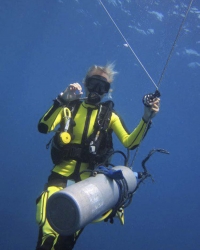 Decompression stop after a deep dive - credit Emmy AhlenUnlike a Decompression Stop, which is absolutely necessary after a deep dive, a ‘Safety Stop’ is just for added safety and it is performed at the end of a non-deco recreational dive. It just adds some extra safety to an already-safe dive with a good profile. Even dive computers will recommend that you perform a scuba safety stop after a regular dive. They usually do this by triggering a 3 minute countdown timer as soon as you ascend to 5.9 metres. The computers have a clever algorithm that knows your exact depth, how long you’ve been at that depth and how long and deep your dive was. The best safety stops are for at least three minutes, and at a depth of five metres. If your safety stop is longer than three minutes, it is even safer. But if you can’t do the whole three minutes for any reason it’s no problem. Some divers might be unable to do a safety stop, and float to the surface. If this happens slowly, it's ok. Don't worry. This normally happens when the diver is low on air (more-bouyant tank) or doesn't have enough weights, or has some air in theor BCD that they didn't release.
Decompression stop after a deep dive - credit Emmy AhlenUnlike a Decompression Stop, which is absolutely necessary after a deep dive, a ‘Safety Stop’ is just for added safety and it is performed at the end of a non-deco recreational dive. It just adds some extra safety to an already-safe dive with a good profile. Even dive computers will recommend that you perform a scuba safety stop after a regular dive. They usually do this by triggering a 3 minute countdown timer as soon as you ascend to 5.9 metres. The computers have a clever algorithm that knows your exact depth, how long you’ve been at that depth and how long and deep your dive was. The best safety stops are for at least three minutes, and at a depth of five metres. If your safety stop is longer than three minutes, it is even safer. But if you can’t do the whole three minutes for any reason it’s no problem. Some divers might be unable to do a safety stop, and float to the surface. If this happens slowly, it's ok. Don't worry. This normally happens when the diver is low on air (more-bouyant tank) or doesn't have enough weights, or has some air in theor BCD that they didn't release.
Decompression Stops are not explained in detail in this article, because we focus on recreational diving. Also, any diver taking part in decompression dives, needs proper training. And all the safety information and procedures are taught, explained & practiced thoroughly during the training process. In short, decompression stops are absolutely necessary because the diver has been deep and for a period of time ‘gone into deco.’ The dive computer will sound a warning telling the diver to stop at least once on his or her ascent. The depth and length of time for each deco stop is calculated by the computer and varies from one dive to the next.
How to Maintain Your Position in a Current?
Some inexperienced divers worry about being carried away in a current during the 3 minute dive safety stop, and this is a valid concern. However, not only is it nothing to worry about, it’s usually a good thing, and it’s often necessary.
If you ascend to a depth of 5 metres you are usually not protected by the reef from any current. Even a gentle current will take you away from the reef during the safety stop. But this is nothing to worry about because at least one of your buddy group should have an SMB (Surface Marker Buoy) also known as a safety sausage. These are to enable all boat captains in the area know that divers are in shallow water below, and that they could surface at any moment. Also, it’s actually good for you to drift away from the reef, because for safety and environmental reasons it’s better to get back on the boat away from the reef. Too near can risk damaging the reef, the boat, or hurt divers. The larger the boat, the further from the reef is its limit
So, if during your safety stop you drift away in a current, it’s no problem and often a good thing. As long as one of you has deployed the safety sausage (SMB), your boat can follow that to pick you up. If you’re doing a shore dive, then you would usually follow the bottom until you can stand up and walk out. But deployment of a safety sausage is still a good idea. Our next section talks about how to maintain or practice your buoyancy during your safety stop, so read on to find out more.
Maintaining Buoyancy During Safety Stops
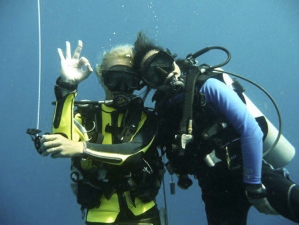 Safety stop - credit Emmy AhlenAs we have already discussed, the scuba safety stop depth is normally 5 metres, or as close to that as is practical. This scuba safety stop is the perfect time to practice your buoyancy skills. If you get it really wrong, it’s unlikely that you will bang into the reef because most safety stops are done in deeper water. And if you ascend too fast, although it’s not ideal, you can only ascend as far as the surface. So the risk of lung expansion or decompression sickness is reduced when compared to doing the same in deeper water.
Safety stop - credit Emmy AhlenAs we have already discussed, the scuba safety stop depth is normally 5 metres, or as close to that as is practical. This scuba safety stop is the perfect time to practice your buoyancy skills. If you get it really wrong, it’s unlikely that you will bang into the reef because most safety stops are done in deeper water. And if you ascend too fast, although it’s not ideal, you can only ascend as far as the surface. So the risk of lung expansion or decompression sickness is reduced when compared to doing the same in deeper water.
But let’s talk about getting it right, not getting it wrong. As we have mentioned, there should be at least one of you with a safety sausage deployed, and holding the reel is the best way to ensure you remain at the correct depth, which is usually 5 metres. Or if there’s a buoy line or mooring line, you can hold on to that. But these ways are not ‘controlling buoyancy,’ they’re simply maintaining your depth.
An easy way to control your buoyancy on the safety stop is to stay level with the person holding the safety sausage reel. Keep looking and him or her, and you’re at the right depth, but doing so by controlling buoyancy. Or if you have a dive computer, then you can watch the numbers on the screen to get a really accurate depth. But staring at a watch for three minutes is no fun, and you might get dizzy or bang into your buddy if you don’t pay attention to what’s around you. Staying at exactly five metres for three minutes is nearly impossible, but it’s good to try your best to remain between 4 metres and 6 metres. Most computers will go out of ‘safety stop mode’ if you descend below 6 metres.
And don’t forget that at the end of your dive, your tank will be lighter (and more buoyant) than at the beginning of your dive. Buoyancy control isn’t easy with a light tank, but a correctly-weighted diver is one who has the right amount of weight for the safety stop, not for the earlier parts of the dive. And one more thing, it’s very common for divers to forget to release any air from their BCD jacket that they had put in earlier in the dive. And if you have air in the BCD and a light tank, it will make you too buoyant and it’s really hard to stay down at 5 metres. You need to release all the air in your BCD before you get to the safety stop. Don’t worry about sinking down, as this won’t happen if you’re correctly weighted. And finally, NEVER EVER inflate your BCD to rise up to the surface! Always swim up slowly, and then inflate your BCD AFTER you have reached the surface. Our next section discusses how to have fun during your safety stop.
Have Fun During Safety Stops
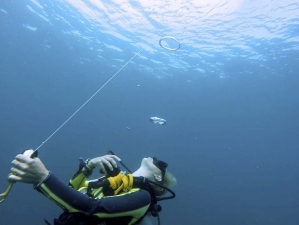 Safety stop bubble rings - credit Emmy AhlenSafety stops might sound boring to some. But hanging around in water away from the reef with nothing to see for three minutes can be a lot of fun. Ok, so if you can stay around the reef for this period, it’s just like part of your dive, but more about that in the final section. When you need to drift away into blue water from the reef or wreck to complete your safety stop, this time can still be enjoyable. Sometimes we’re lucky enough to have fish swimming around us during the safety stop, and many divers have enjoyed the company of sharks and rays! But if there’s nothing other than your dive buddies, you can still have fun.
Safety stop bubble rings - credit Emmy AhlenSafety stops might sound boring to some. But hanging around in water away from the reef with nothing to see for three minutes can be a lot of fun. Ok, so if you can stay around the reef for this period, it’s just like part of your dive, but more about that in the final section. When you need to drift away into blue water from the reef or wreck to complete your safety stop, this time can still be enjoyable. Sometimes we’re lucky enough to have fish swimming around us during the safety stop, and many divers have enjoyed the company of sharks and rays! But if there’s nothing other than your dive buddies, you can still have fun.
Blowing bubble rings or making them with your hands is a common activity, and the safety stop is the ideal time to learn or practice. It’s quite common to see dive guides entertaining themselves and their guests by blowing or making bubble rings during safety stops. And the activity can become quite contagious. Other fun activities are taking selfies or doing somersaults. But it’s vital that everyone controls their buoyancy to remain at approximately five metres, and not ascend or descend out of that depth range. Swapping or removing equipment, or playing with air valves is a BAD IDEA at any time during the dive, and especially so during the safety stop. A dive isn’t over until you’re all safely out of the water.
Waiting For The Boat
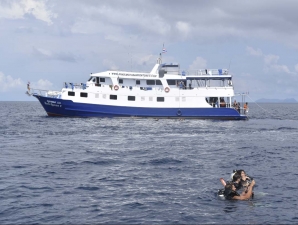 If you’re diving from a boat, you nearly always need that same boat to collect you at the end of your dive. And unless you’re the only divers aboard, the boat needs to also collect others. Picking everyone up as quickly & safely as possible is made harder if they surface at the same time but in different places. So if you deploy the safety sausage before your start your safety stop, the boat can sometimes sail to near your location for when you surface. Of course, it can’t be too near, because that’s dangerous. But nearby is nice and convenient. In our next, and final, section we discuss safety stops at shallow reefs, so keep reading to find out more.
If you’re diving from a boat, you nearly always need that same boat to collect you at the end of your dive. And unless you’re the only divers aboard, the boat needs to also collect others. Picking everyone up as quickly & safely as possible is made harder if they surface at the same time but in different places. So if you deploy the safety sausage before your start your safety stop, the boat can sometimes sail to near your location for when you surface. Of course, it can’t be too near, because that’s dangerous. But nearby is nice and convenient. In our next, and final, section we discuss safety stops at shallow reefs, so keep reading to find out more.
Shallow-Reef Safety Stops
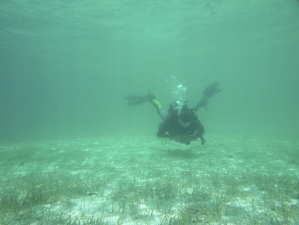 Shallowing up on the bottom - credit Johan FolmeusPossibly the most-ideal PADI safety stop experience is when you can do it on a shallow reef. A safety stop over the reef is really just an extension of the rest of your dive. It’s important that you keep an eye on and maintain your depth, because it’s quite easy to get distracted and not realise that the reef is getting shallower or deeper. Also, whoever is holding the safety sausage needs to be careful that the string doesn’t become entangled in the coral or with anyone who might be snorkelling at the surface.
Shallowing up on the bottom - credit Johan FolmeusPossibly the most-ideal PADI safety stop experience is when you can do it on a shallow reef. A safety stop over the reef is really just an extension of the rest of your dive. It’s important that you keep an eye on and maintain your depth, because it’s quite easy to get distracted and not realise that the reef is getting shallower or deeper. Also, whoever is holding the safety sausage needs to be careful that the string doesn’t become entangled in the coral or with anyone who might be snorkelling at the surface.
So now that you know a bit more about scuba diving safety stops, it’s time to get back in the water and practice your buoyancy or bubble rings. We offer scuba diving liveaboard trips in many countries, and there’s no time better than now to start thinking about your next diving adventure.
Special offers are always available for early and last-minute bookings, so what are you waiting for? Get in touch today!

